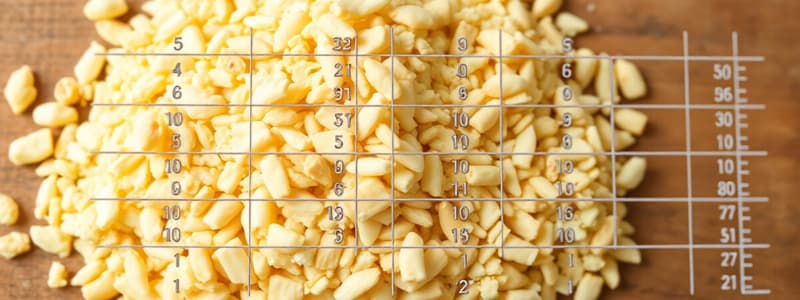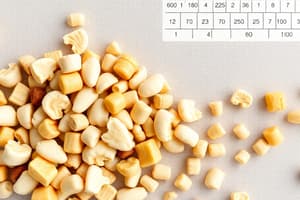Podcast
Questions and Answers
The Weende system, developed in the mid-19th century, is also known as ______ analysis.
The Weende system, developed in the mid-19th century, is also known as ______ analysis.
proximate
In proximate analysis, ______ is estimated by multiplying the nitrogen content of the feed by a factor, typically 6.25.
In proximate analysis, ______ is estimated by multiplying the nitrogen content of the feed by a factor, typically 6.25.
crude protein
[Blank], representing the soluble carbohydrates like sugars and starches, is calculated by subtracting the sum of other fractions from 100.
[Blank], representing the soluble carbohydrates like sugars and starches, is calculated by subtracting the sum of other fractions from 100.
nitrogen-free extract
The Kjeldahl method is commonly used to determine ______ by digesting a sample in sulfuric acid and quantifying the resulting ammonia.
The Kjeldahl method is commonly used to determine ______ by digesting a sample in sulfuric acid and quantifying the resulting ammonia.
Ether extract primarily measures fat content but may also include ______, waxes, and other lipids.
Ether extract primarily measures fat content but may also include ______, waxes, and other lipids.
Crude fiber mainly consists of cellulose, hemicellulose, and ______, representing the indigestible carbohydrate fraction.
Crude fiber mainly consists of cellulose, hemicellulose, and ______, representing the indigestible carbohydrate fraction.
To determine ash content, a feed sample is heated in a ______ until all organic matter is burned away, leaving only the inorganic residue.
To determine ash content, a feed sample is heated in a ______ until all organic matter is burned away, leaving only the inorganic residue.
In crude fiber analysis, a dried, fat-extracted sample is boiled in dilute acid and then dilute ______ to isolate the indigestible residue.
In crude fiber analysis, a dried, fat-extracted sample is boiled in dilute acid and then dilute ______ to isolate the indigestible residue.
______ uses infrared light to rapidly predict the chemical composition of feed samples, offering a faster and more cost-effective alternative to wet chemistry methods.
______ uses infrared light to rapidly predict the chemical composition of feed samples, offering a faster and more cost-effective alternative to wet chemistry methods.
The Weende system, while providing a basic understanding of nutrient content, does not offer information on specific ______, limiting its use in precise diet formulation.
The Weende system, while providing a basic understanding of nutrient content, does not offer information on specific ______, limiting its use in precise diet formulation.
The ______ is prone to error since it accumulates the errors from all other analyses, leading to inaccurate carbohydrate estimation.
The ______ is prone to error since it accumulates the errors from all other analyses, leading to inaccurate carbohydrate estimation.
______ is a more advanced method than the Weende system, and it separates fiber into neutral detergent fiber (NDF) and acid detergent fiber (ADF), providing a better estimate of total dietary fiber and its components.
______ is a more advanced method than the Weende system, and it separates fiber into neutral detergent fiber (NDF) and acid detergent fiber (ADF), providing a better estimate of total dietary fiber and its components.
The Weende system is used to ______ for livestock, providing a basic understanding of the nutrient content in feedstuffs.
The Weende system is used to ______ for livestock, providing a basic understanding of the nutrient content in feedstuffs.
______ enables the precise measurement of mineral content in feed samples, providing a comprehensive mineral profile.
______ enables the precise measurement of mineral content in feed samples, providing a comprehensive mineral profile.
One disadvantage of Ether Extract (EE) is that it measures total lipids but does not differentiate between nutritional and non-nutritional lipids, resulting in an ______ the energy value.
One disadvantage of Ether Extract (EE) is that it measures total lipids but does not differentiate between nutritional and non-nutritional lipids, resulting in an ______ the energy value.
The method for Crude Fiber (CF) in the Weende system can lead to inconsistent results due to variations in the ______ treatments.
The method for Crude Fiber (CF) in the Weende system can lead to inconsistent results due to variations in the ______ treatments.
______ and mass spectrometry are used to determine the specific fatty acid profiles in feedstuffs, offering a more accurate assessment of fat quality.
______ and mass spectrometry are used to determine the specific fatty acid profiles in feedstuffs, offering a more accurate assessment of fat quality.
Proximate analysis, like the Weende system, aids in predicting the ______ of feedstuffs, which is essential for meeting the energy requirements of animals.
Proximate analysis, like the Weende system, aids in predicting the ______ of feedstuffs, which is essential for meeting the energy requirements of animals.
Flashcards
Weende System
Weende System
A method to assess feed's nutritional value by separating components into fractions.
Moisture (in feed analysis)
Moisture (in feed analysis)
Water content in a feed sample, found by weight loss after drying.
Crude Protein (CP)
Crude Protein (CP)
Estimated protein content based on nitrogen content multiplied by a factor.
Ether Extract (EE)
Ether Extract (EE)
Signup and view all the flashcards
Crude Fiber (CF)
Crude Fiber (CF)
Signup and view all the flashcards
Ash (in feed)
Ash (in feed)
Signup and view all the flashcards
Nitrogen-Free Extract (NFE)
Nitrogen-Free Extract (NFE)
Signup and view all the flashcards
Kjeldahl Method
Kjeldahl Method
Signup and view all the flashcards
Advantages of Weende System
Advantages of Weende System
Signup and view all the flashcards
Disadvantages of Weende System
Disadvantages of Weende System
Signup and view all the flashcards
Van Soest Fiber Analysis
Van Soest Fiber Analysis
Signup and view all the flashcards
Near-Infrared Reflectance Spectroscopy (NIRS)
Near-Infrared Reflectance Spectroscopy (NIRS)
Signup and view all the flashcards
Amino acid analysis by chromatography
Amino acid analysis by chromatography
Signup and view all the flashcards
Inductively Coupled Plasma (ICP) Spectroscopy
Inductively Coupled Plasma (ICP) Spectroscopy
Signup and view all the flashcards
Study Notes
- The Weende system, also known as proximate analysis, assesses the nutritional value of animal feeds.
- It was developed in the mid-19th century by Wilhelm Henneberg and Friedrich Stohmann at the Weende Experiment Station in Germany.
- The system separates feed components into six fractions.
- Moisture
- Crude protein
- Ether extract (crude fat)
- Crude fiber
- Ash
- Nitrogen-free extract (NFE)
- The Weende system is simple and inexpensive.
- It has limitations in accurately representing specific nutrient content and digestibility.
Proximate Analysis Fractions
- Moisture is determined by drying a sample in an oven until a constant weight is achieved.
- The weight loss is considered moisture content.
- Crude Protein (CP) is estimated by measuring the nitrogen content of the feed and multiplying it by a factor, typically 6.25.
- This calculation assumes that proteins contain 16% nitrogen.
- Ether Extract (EE), or crude fat, is determined by extracting a dried sample with ether.
- The extracted material contains primarily fat, but may also include pigments, waxes, and other lipids.
- Crude Fiber (CF) represents the indigestible carbohydrate fraction.
- Mainly cellulose, hemicellulose, and lignin.
- Determined by sequential extraction with dilute acid and alkali.
- Ash is the inorganic residue remaining after burning a sample at high temperature (500-600°C).
- Represents the total mineral content.
- Nitrogen-Free Extract (NFE) is calculated by subtracting the sum of CP, EE, CF, moisture, and ash from 100.
- Supposed to represent the soluble carbohydrates like sugars and starches.
Determination of fractions
- To determine moisture, a feed sample is weighed and then dried in an oven, typically at 105°C, until a constant weight is achieved.
- The difference in weight represents the moisture content.
- For crude protein, the Kjeldahl method is commonly used.
- The sample is digested in sulfuric acid, converting nitrogen to ammonium sulfate.
- Ammonia is then distilled off, collected, and quantified by titration.
- Ether extract uses diethyl ether in a Soxhlet apparatus to extract a dried feed sample.
- The ether is evaporated, and the residue is weighed to determine the fat content.
- Crude fiber analysis involves boiling a dried, fat-extracted sample in dilute acid and then dilute alkali.
- The remaining undissolved residue is dried, weighed, ashed, and the loss on ignition is the crude fiber.
- To determine ash, a feed sample is placed in a muffle furnace and heated to a high temperature (e.g., 600°C) until all organic matter is burned away, leaving only the inorganic ash.
- Nitrogen-free extract is not directly measured but calculated using the formula: NFE = 100 - (Moisture + CP + EE + CF + Ash).
Advantages
- The Weende system is relatively simple and inexpensive to perform.
- Making it accessible for routine feed analysis.
- It provides a basic overview of the major nutrient fractions in feedstuffs.
- It has been used for a long time.
- Providing a historical dataset for comparing feed compositions.
- It serves as a standard method in feed labeling regulations.
- Ensuring a degree of consistency in nutritional information.
Disadvantages
- Ether Extract (EE) measures total lipids but does not differentiate between nutritional and non-nutritional lipids.
- Resulting in an overestimation of the energy value.
- Crude Fiber (CF) does not accurately represent total dietary fiber.
- Underestimates hemicellulose, pectin, and other soluble fibers, leading to an incomplete assessment of fiber's nutritional impact.
- The method for Crude Fiber (CF) can lead to inconsistent results.
- Due to variations in the severity of the acid and alkali treatments.
- The calculation of Nitrogen-Free Extract (NFE) is prone to error.
- Since it accumulates the errors from all other analyses, leading to inaccurate carbohydrate estimation.
- It does not provide information on specific amino acids, fatty acids, vitamins, or minerals.
- Limiting its use in precise diet formulation.
Alternatives and advancements
- Van Soest Fiber Analysis is a more advanced method that separates fiber into neutral detergent fiber (NDF) and acid detergent fiber (ADF).
- Providing a better estimate of total dietary fiber and its components.
- Near-Infrared Reflectance Spectroscopy (NIRS) uses infrared light to rapidly predict the chemical composition of feed samples.
- Offering a faster and more cost-effective alternative to wet chemistry methods.
- Amino acid analysis by chromatography provides detailed quantification of individual amino acids.
- Improving the precision of protein evaluation.
- Gas chromatography and mass spectrometry are used to determine the specific fatty acid profiles in feedstuffs.
- Offering a more accurate assessment of fat quality.
- Inductively Coupled Plasma (ICP) Spectroscopy enables precise measurement of mineral content in feed samples.
- Providing a comprehensive mineral profile.
Applications in animal nutrition
- The Weende system is used to formulate balanced diets for livestock.
- Providing a basic understanding of the nutrient content in feedstuffs.
- It evaluates the nutritional quality of different feed ingredients.
- Helping nutritionists select appropriate components for animal diets.
- The system ensures compliance with feed labeling regulations.
- Providing consumers with information about the nutritional content of animal feeds.
- It monitors feed quality and consistency over time.
- Identifying potential issues with nutrient content or ingredient composition.
- Proximate analysis helps predict the energy value of feedstuffs.
- Which is essential for meeting the energy requirements of animals.
Studying That Suits You
Use AI to generate personalized quizzes and flashcards to suit your learning preferences.




